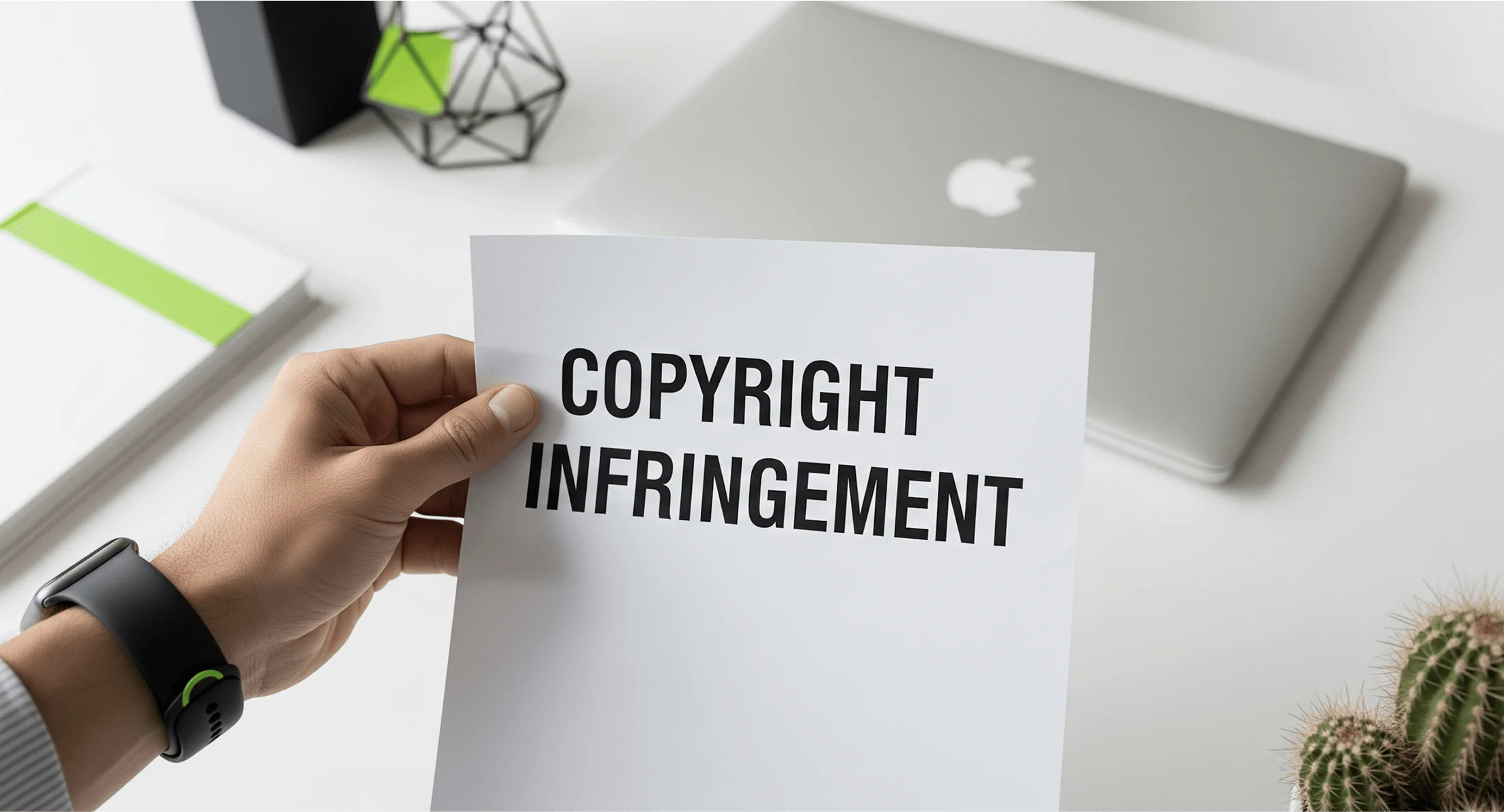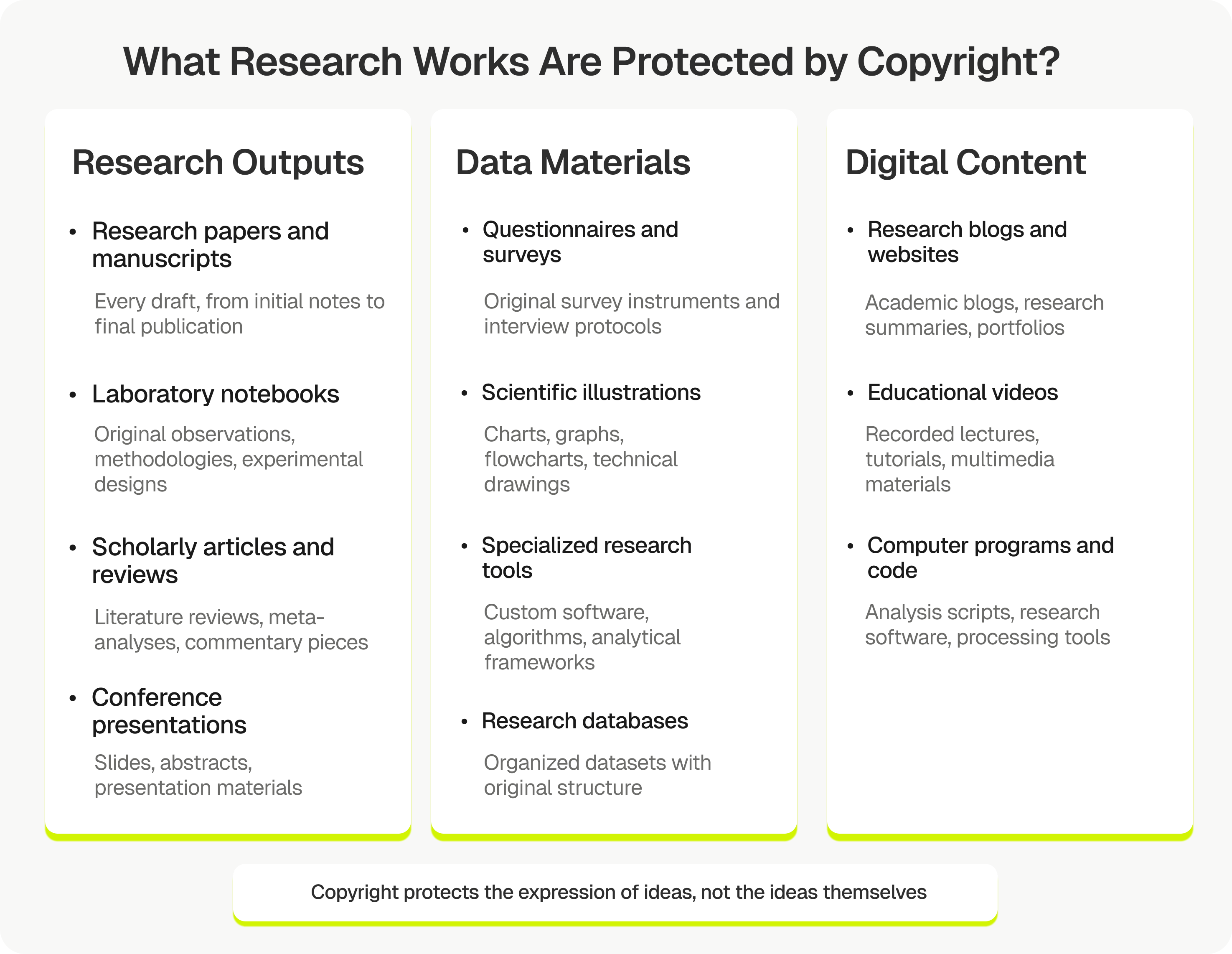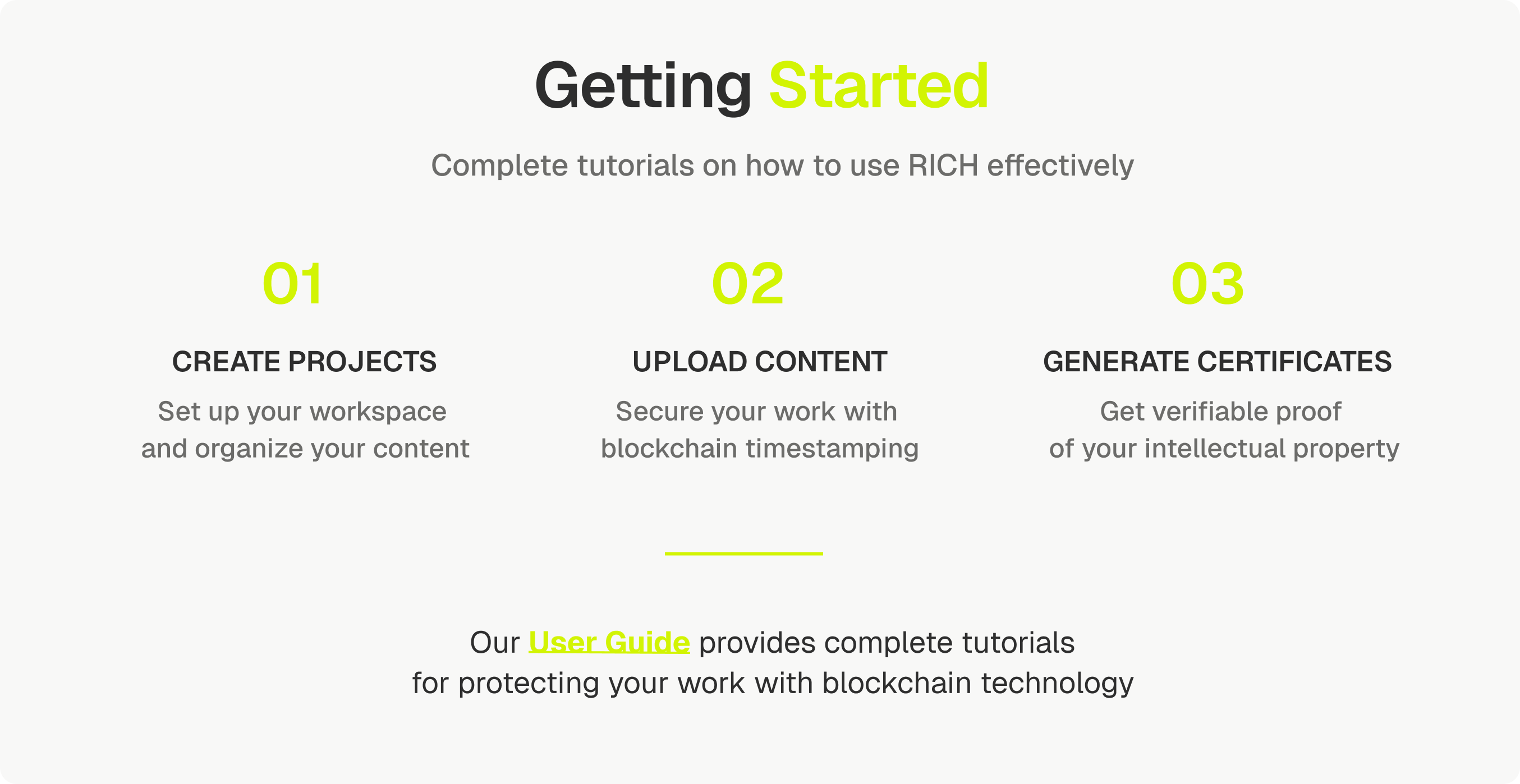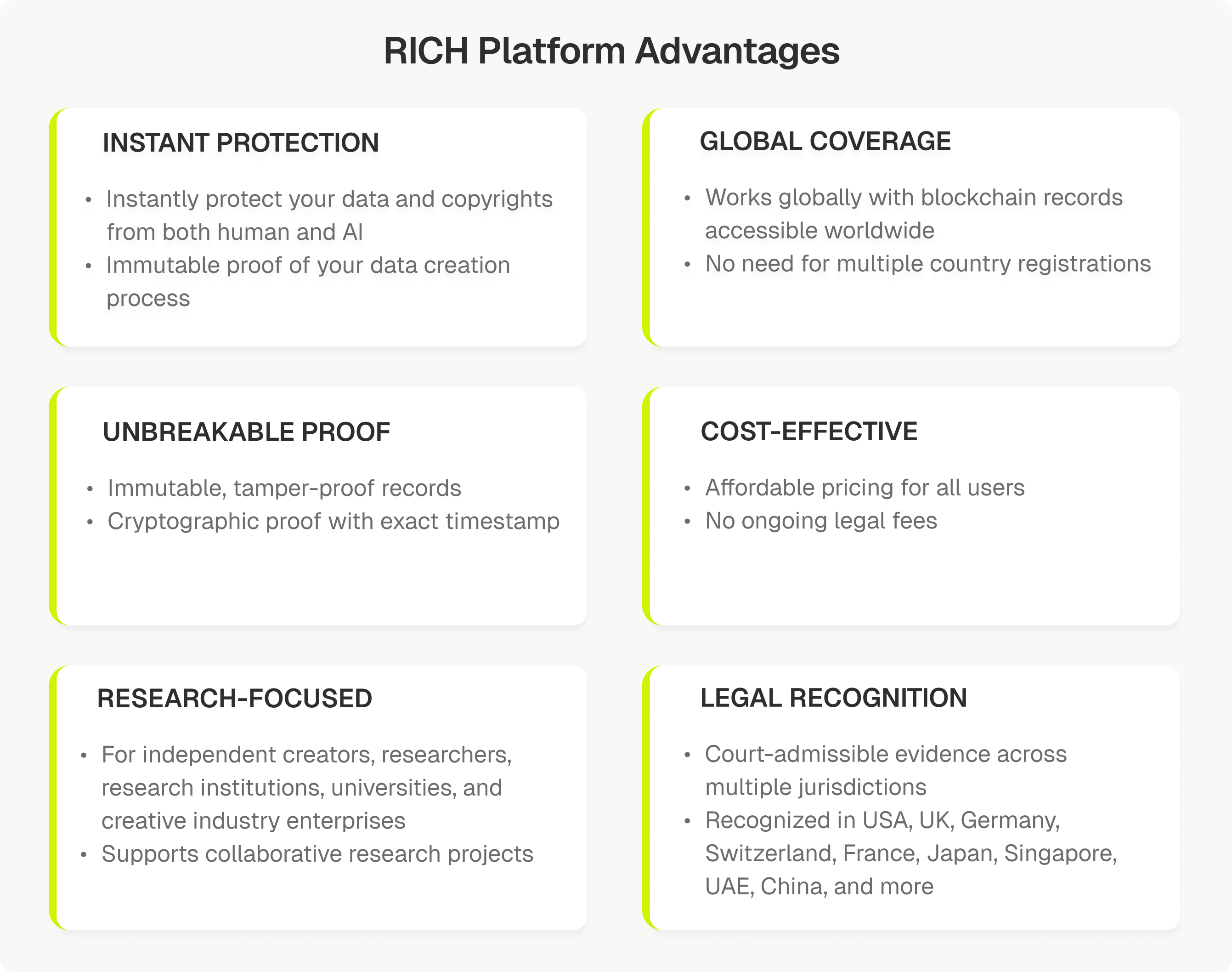Copyright Infringement: Definition, Examples, and How to Avoid It
Understanding how copyright infringement can happen is essential for anyone who creates, shares, or uses content today. Knowing copyright law benefits everyone, from researchers and content creators to business owners and everyday internet users. This understanding protects you from legal consequences when using others' content. It also helps safeguard your own intellectual property.

What Is Copyright Infringement?
Copyright infringement occurs when someone uses, copies, distributes, or creates new works from copyrighted material without getting permission from the owner. This kind of unauthorized use violates the exclusive rights granted to creators by copyright law.
The legal definition of copyright infringement includes two forms:
Direct infringement occurs when someone directly violates the copyright owner's rights.
Secondary infringement occurs when someone helps, supports, or benefits from another person's direct infringement.
What Types of Works Are Protected by Copyright?
Copyright protects "original works of authorship fixed in a tangible medium." These are:
- Literary works (books, articles, blogs)
- Scholarly works, journal articles, and scholarly manuscripts
- Musical works and sound recordings
- Dramatic works and musical accompaniment
- Pantomimes and choreographic works
- Paintings, graphics, and sculptures (including scientific illustrations and diagrams)
- Motion pictures and audiovisual works
- Architectural works
- Computer programs, software, and specialized research tools
- Laboratory notebooks with original expressions
- Questionnaires, surveys, and assessment tools with original content
Researchers need to understand several important copyright distinctions.
When you create something, copyright instantly protects it. This protection exists even before you officially publish the work.
Copyright doesn't protect facts and basic data that you find while doing research. But copyright protects the exact ways that articles evaluate, analyze, and present that material.
Copyright Infringement Examples
Copyright infringement occurs in various forms across different contexts.
These examples illustrate typical infringement scenarios:
- Downloading or sharing music, movies, or software from unauthorized sources
- Copying significant portions of articles, books, or other texts without permission
- Using online images without a license or consent
- Making translations, sampling music, or creating derivatives without permission
- Distributing copies or publicly performing copyrighted works without authorization
Copyright Infringement in Research
In academic and research settings, copyright infringement appears in several common ways.
Sometimes, researchers copy large parts of articles or books, going beyond fair use limits. Problems also occur when scholars share multiple copies of copyrighted materials with colleagues without getting the required permissions. Many researchers accidentally break copyright rules when they use protected images, graphs, tables, or large parts of someone else's data without proper permission or credit.
Other common copyright violations in research include translating someone's work without getting their permission first.
Researchers also infringe when sharing paid journal articles on public websites without obtaining the necessary distribution rights. Additionally, using specialized research software or patented methodologies without purchasing the required license violates intellectual property rights.
Researchers must be particularly vigilant about copyright infringement because it can affect their legal standing, academic integrity, and professional reputation. In research, ethical practices and respect for IP rights are critical to career advancement, grant funding, and collaboration opportunities.
Famous Copyright Infringement Cases
Understanding copyright cases helps creators and researchers recognize potential infringement scenarios and learn from legal precedents. These cases highlight the different ways copyright violations can happen, ranging from issues in academic research and peer review misuse to artistic expression and modern AI disputes.
This case focused on the abuse of academic peer review, in which a researcher stole ideas from competitors by using confidential information. C. David Bridges, a biologist at Baylor College of Medicine, was asked to review an unpublished manuscript from Harvard University researchers about eye enzyme research.
The National Institutes of Health investigation concluded that Bridges stole information and ideas from the Harvard manuscript and used them to produce his own study, which he published in the prestigious journal Science. The NIH stated that "Dr. Bridges did plagiarize the manuscript. He misused the privileged information available to him."
This case established that peer reviewers cannot exploit confidential manuscripts for their own research. It also demonstrated how blockchain timestamping could protect the original researchers' intellectual property and priority.
ResearchGate, an academic social networking site with over 13 million users, dealt with lawsuits from major publishers alleging "massive copyright infringement." Publishers claimed that researchers were uploading millions of copyrighted papers to the platform without proper authorization.
After years of litigation in Germany and the U.S., the parties reached a settlement in 2023. The settlement includes an automated system to check copyright status when researchers upload papers. The case showed that many researchers unknowingly violate copyright when sharing their published work.
This case shows the complexity of modern academic copyright and how researchers need clear verification of their rights to share their work safely and legally.
The Authors Guild has sued OpenAI. They say that ChatGPT was trained on millions of copyrighted books. They claim this was done without permission from the authors or publishers. The case shows a new type of copyright violation. AI companies use many creative works to train their models.
The lawsuit argues that AI companies "feed copyright-protected works into their models without getting permission from the copyright holders or paying for them." This ongoing case could set important legal precedents regarding the use of copyrighted materials by AI.
This shows how new technologies create new copyright problems and why traditional tools can no longer protect IP. It also demonstrates why clear proof of authorship and ownership has become essential in the age of AI.
Contemporary artist Jeff Koons created a sculpture called "String of Puppies." He based it directly on a postcard photograph called "Puppies" by Art Rogers. Koons claimed that his work served as a parody and a commentary on commercial culture, but the court saw things differently. Ultimately, they rejected Koons's fair use argument, deciding that his use was commercial rather than transformative.
This case clarified the limits of art that borrows from other works. It showed that even when artists use existing works, they must change them a lot to follow fair use rules.
Legal Consequences of Copyright Infringement
Copyright infringement penalties can be serious. They depend on intent, profit, and the amount of material used.
The legal system makes a clear distinction between two types of infringement:
Innocent infringement occurs when someone truly didn't know they were breaking copyright laws.
Willful infringement happens when a person knowingly ignores those protections.
Copyright infringement can have serious consequences in academic and scientific settings. These include institutional penalties and legal action. Such violations can have a significant impact on careers and research initiatives.
What Are the Statutory Damages for Copyright Infringement?
According to U.S. copyright law, particularly 17 U.S. Code § 504, the statutory damages for copyright infringement can vary significantly. Here's how it works:
- Damages for standard infringement can vary from $750 to $30,000 for each infringed work.
- In cases of willful infringement, that amount can jump to as high as $150,000 per work.
- Courts can award damages as low as $200 per work for innocent infringement.
These statutory damages enable copyright holders to pursue compensation without demonstrating actual damages. Proving actual damages can often be difficult to accomplish.
Copyright Infringement Penalties
Copyright infringement can result in severe penalties beyond statutory damages.
For instance, courts may award actual damages and lost profits. These penalties require infringers to compensate copyright holders for their financial losses. Judges often issue injunctions to stop the infringement and prevent it from happening again.
In severe cases, courts might order the confiscation and destruction of infringing materials to stop further distribution. Courts usually require infringers to cover legal costs and attorney fees. These costs often surpass the damages themselves.
Criminal penalties may apply for willful copyright infringement. These penalties may include fines of up to $250,000 for each offense. They can also involve imprisonment for up to five years. Some cases result in both fines and imprisonment.
Repeat offenders face increased penalties.
These severe consequences underscore the importance of understanding copyright law. For researchers and academics, understanding these penalties shows the critical need to obtain proper permissions and licenses. Respecting copyright is vital for avoiding legal problems and maintaining academic integrity and professional credibility within scholarly communities.
How Does Infringement Impact Academic and Professional Reputation?
Copyright infringement can harm your reputation in addition to the legal implications.
Here are some potential consequences you may face:
- A loss of credibility in the academic world and a hit to your trustworthiness
- The possibility of having your published works retracted
- Disciplinary measures from your institution or employer
- Challenges in getting future works published
- Loss of funding opportunities
- Fewer chances for collaboration
- Lasting damage to your professional reputation
For researchers and academics, a damaged reputation can be as serious as legal problems. It affects their career direction. It also harms the professional relationships they build.
How to Avoid Copyright Infringement?
Proactively preventing copyright infringement is always better than dealing with its consequences.
Here are some strategies to help you stay compliant:
- Presume that all content is protected.
Assume that everything is copyrighted unless you know it is in the public domain.
- Obtain the necessary permissions.
Always ask the copyright holders for permission before using their work.
- Use legal licensing providers
Use reputable licensing services for photos, music, and other media to ensure proper rights.
- Understand fair use limitations.
Before relying on fair use, carefully consider the four factors. Don't assume that educational use automatically qualifies.
- Use open-access resources.
Prioritize works in the public domain, content licensed under Creative Commons, and open-access materials.
- Document all permissions.
Keep detailed records of all permissions, licenses, and rights that you obtain for future reference.
Best Practices for Researchers
Researchers deal with special copyright challenges when using the work of others. Following these recommendations helps avoid infringement problems in research.
- Document everything systematically.
During literature reviews, keep detailed records of all sources, including their copyright status. This creates a clear audit trail for future reference. It also helps you determine what permissions you may need.
- Always seek permission for substantial use.
Don't assume that fair use applies when including substantial portions of another person's research. When using datasets, specialized research tools, or unique methodologies, understand and follow their specific licensing terms.
- Understand the limits of citation.
Proper attribution does not prevent copyright infringement; you still need permission, even when citing correctly.
- Check publisher requirements early.
Before submitting your work, review the journal's guidelines, as permissions and fair use restrictions vary by publisher. Some publishers may require confirmation that you have obtained the rights to all sources used.
- Leverage open science resources.
Consider using open science databases and resources with well-defined license terms to access quality research materials while avoiding copyright complications.
- Get expert help when needed.
Consult librarians and copyright professionals at your institution for complex licensing issues.
When Do You Need Permissions and Licenses?
To stay compliant with copyright rules, you need to know when to ask for official permission or a license.
Usually, you need permission or a license to use significant amounts of someone else's copyrighted material. Although short excerpts may qualify as fair use, larger sections almost always require authorization. If you plan to use content for commercial purposes, permission is almost always necessary. This applies even if the same usage would be acceptable in an educational setting.
When adapting or modifying another person's work, you need to secure rights from the original creator. Similarly, distributing or publicly showing copyrighted material usually necessitates permission.
If your intended use doesn't fit within the exceptions that fair use provides, you'll need to go ahead and seek that permission. The same applies when using content beyond its existing license terms. You'll need additional permissions in these cases too.
Luckily, many content creators provide a range of licensing options. These can vary from traditional copyright processes to Creative Commons licenses. Creative Commons licenses clearly outline what uses they allow. These licenses can greatly assist in lawfully including other people's work in your efforts.
How to Protect Your Work from Copyright Infringement?
As a creator, it is essential to take steps to protect your IP. Global networks make sharing and copying material simple.
Content producers and researchers spend months or years creating original content. Strong protective policies shield your intellectual efforts and give you control over how your work is used, distributed, and monetized.
- Register your copyright and apply copyright notices
- Use digital rights management (DRM) or watermarks
- Monitor for illegal use with specialized tools
- Document your creative process with dated drafts and development materials
- Obtain necessary permissions and educate your audience about usage rights
- Or streamline everything with the RICH platform. RICH is the world's first solution that instantly protects valuable data and intellectual property from humans and AI. The platform uses blockchain verification, immutable timestamping, and proof of authorship to secure your work. It combines multiple protection techniques into one comprehensive solution
How Can Blockchain Verify and Prove Authorship?
RICH uses blockchain technology to create immutable timestamps for valuable content. These timestamps prove when you created your work and protect it from both humans and AI. Using cryptographic records, our system tracks all interactions with your work and offers tools to manage ownership rights and control the use of your data.
Key features include:
- Immutable, tamper-proof records of your data creation process
- Tracks all interactions with your work using cryptographic records
- Court-admissible evidence across the globe: USA, UK, Germany, Switzerland, France, Japan, Singapore, UAE, China, and more
- Ability to prove human contributions in AI-assisted work
- The platform works globally, and blockchain records are accessible worldwide.
The RICH platform is specifically designed for independent creators, researchers, research institutions, universities, and creative industry enterprises who need verifiable proof of their intellectual property.
How to Report Copyright Infringement?
When you discover that someone is using copyrighted material without permission, you can report the infringement to help protect IP rights.
- Identify the infringement clearly
Document what copyrighted work is being used, where it's being used, and who owns the original copyright. Take screenshots or save evidence of the unauthorized use.
- Contact the copyright owner
If you're not the copyright holder, notify the original creator or publisher about the infringement. Provide them with the evidence you've gathered so they can take action.
- Report to the platform or hosting service
For online infringement, most websites and platforms have reporting mechanisms. Submit a formal complaint through their copyright infringement reporting system with detailed evidence.
- Use official reporting channels
Some institutions and organizations have formal procedures for reporting academic misconduct or copyright violations. Follow their specific guidelines for reporting suspected infringement.
- Consider legal action for serious cases
For significant or persistent infringement, the copyright holder may file a lawsuit. This legal action may result in monetary damages, injunctions, and other remedies.
In our content-centered world, understanding copyright infringement is important. The effects on researchers are particularly significant. Copyright violations can damage one's legal standing, professional reputation, and research integrity. Taking preventive steps to stay compliant helps preserve trust and credibility. Properly protecting research work is essential for career success.
The RICH platform offers creators, researchers, and institutions a powerful tool for establishing and protecting their intellectual property from both humans and AI. It uses blockchain verification to secure priority and prove human authorship in the age of AI.
- U.S. Copyright Office: copyright.gov
- Stanford University Libraries: Copyright & Fair Use - fairuse.stanford.edu
- Creative Commons: creativecommons.org
- World Intellectual Property Organization: wipo.int
- Copyright Clearance Center: copyright.com
- RICH Platform: researchintegritychain.com
Insights Unlocked: Intellectual Property
Discover essential insights for protecting your works






